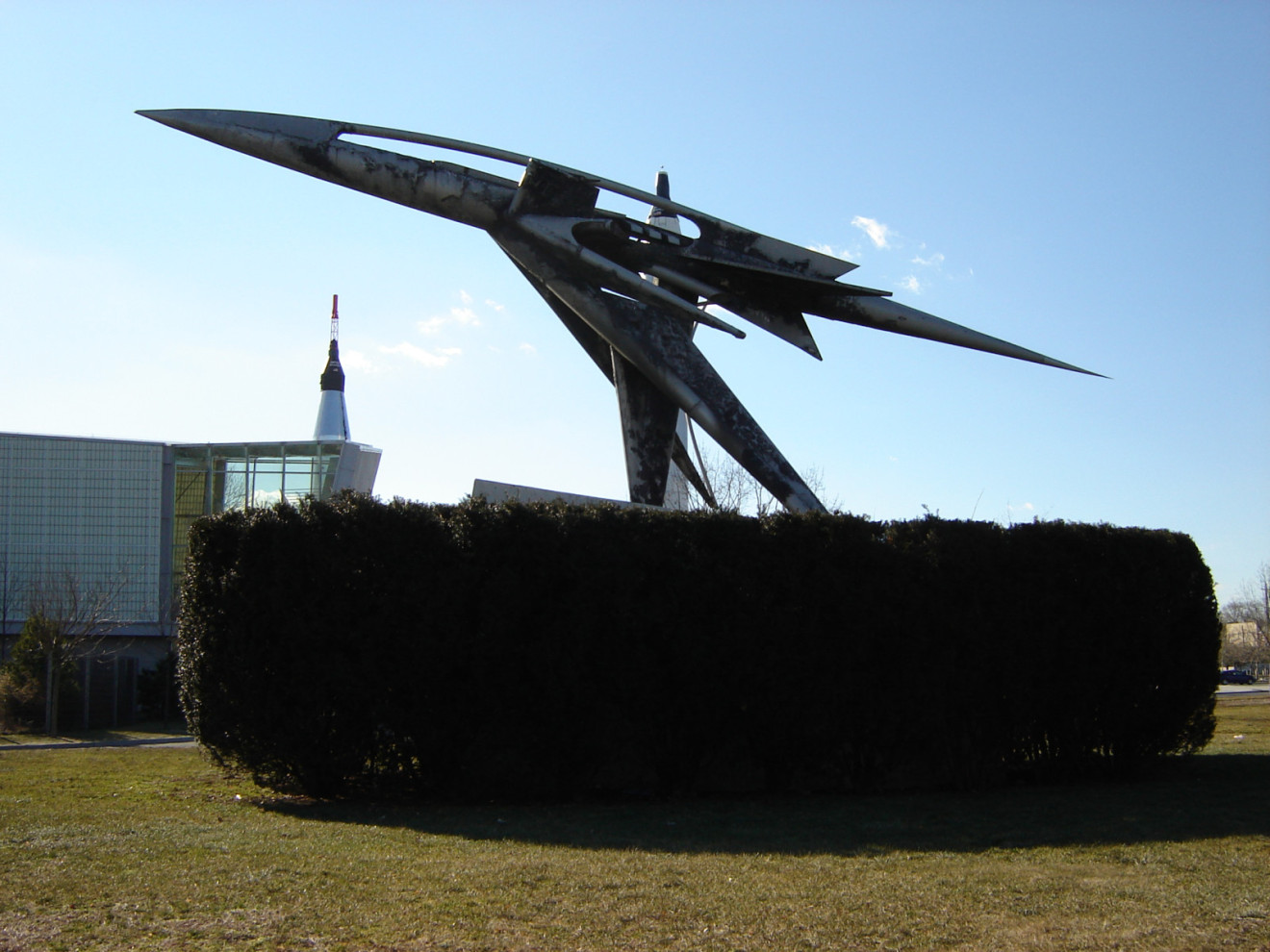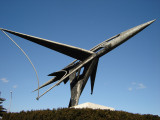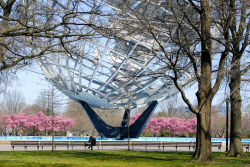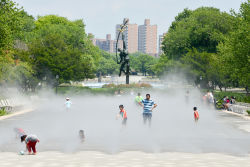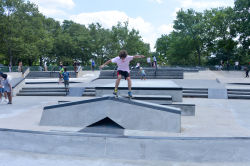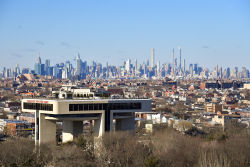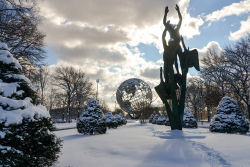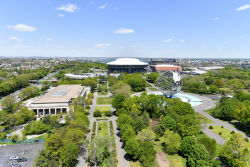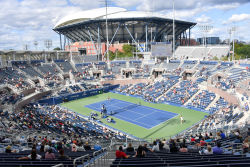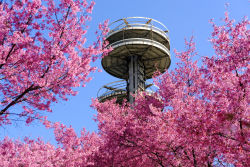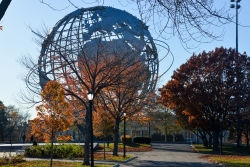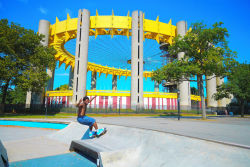Flushing Meadows Corona Park
View all monuments in NYC Parks, as well as temporary public art installations on our NYC Public Art Map and Guide.
Forms in Transit
| Artist: | Theodore Roszak |
| Dedicated: | 1964 |
| Location: | Northeast of Hall of Science |
Artwork History
Located on the grounds of the New York Hall of Science, this distinctive sculpture, dating to 1964, is by the modernist sculptor Theodore Roszak (1907–1981). It was commissioned as part of the permanent sculptural program of the New York World’s Fair of 1964-65, held in Flushing Meadows-Corona Park.
In 1961, the New York World’s Fair Corporation, under the direction of former Parks Commissioner Robert Moses (1888–1981), established a Committee on Sculpture to select sculptors whose work ranged “from contemporary conservative to the more conservative avant-garde.” The committee arrived at a short list of ten recommended modernist sculptors, many of whom displeased the traditional tastes of Moses and the fair’s chief designer Gilmore Clarke (1892–1982). Ultimately, five sculptors were commissioned to create pieces which would stay in the park after the fair ended, including Roszak, Paul Manship (1885–1966), Marshall Fredericks (1908–1998), Jose de Rivera (1904–1985), and Donald De Lue (1897–1988).
Roszak was born in Poznan, Poland on May 1, 1907. His family came to the United States when he was two years old, settling in Chicago. Roszak studied art in his youth at the Art Institute Professional School in the city. In 1926, he moved to New York, and received instruction at the National Academy of Design, as well as from private lessons with painter George Luks (1867-1933). He also took philosophy courses at Columbia University, which he later said had a profound influence on his understanding of “intangible forces which control men’s lives.”
In 1927, he resumed his studies at the Art Institute of Chicago, still largely unaffected by modern trends in art. A fellowship in Europe in 1929 broadened his horizons, exposing him to Cubism, Fauvism, and Expressionism in Paris, Germany, and Prague, causing him to adopt a new, more abstract aesthetic. Besides painting, he took up sculpture and won the Louis Comfort Tiffany award in 1931. With the proceeds, he married and settled on Staten Island.
By the late 1930s he had developed a streamlined style of constructionist sculpture, strongly influenced by Bauhaus principles of architecture and design and his association with Laszlo Moholy-Nagy’s Design Laboratory in New York City. Yet Roszak felt the search for pure forms emotionally bankrupt, and he sought to fuse modern techniques with dynamic expression. During World War II, Roszak was employed on an assembly line at the Brewster Aircraft Corporation, and this experience would have a significant impact on the methods and materials he used in his post-war sculpture.
Roszak’s Spectre of Kitty Hawk sculpture (1946-47) in the collection of the Museum of Modern Art, is less about a specific aircraft than about the spirit of flight. By the 1950s Roszak had “attained recognition as the leading Abstract Expressionist sculptor in America.” A retrospective of his work in 1956 at the Whitney Museum of American Art brought him to a wider audience, and he maintained a strong reputation for striking sculpture through the remainder of his career. In New York City Roszak also sculpted the 25-foot tall bronze sculpture called Sentinel (1966-68) at the Public Health Laboratories on First Avenue and 27th Street.
Forms in Transit is a massive 43-foot long sculpture of aluminum and steel tubes and sheet metal. It suggests an aircraft, with fuselage and wings, but it is also meant to embody the concept of motion and change. The work is in keeping with one of the central themes of the fair, space exploration, and complemented several other significant features in the park, such as the Rocket Thrower statue, Court of Astronauts, Fountain of the Planets, Space Park and the Unisphere.
Portions of a damaged wing were removed in 1970. Though environmental corrosion is evident, some of the patchy, blistered surface of the sculpture appears to be original to the piece, and intended to suggest the incendiary voyage of the vessel as it passes at rapid speed through the atmosphere.
Artwork Details
| Description: | Large composition on pedestal |
| Materials: | Composition--sheet metal and tube metal (aluminum and iron?); Pedestal--concrete |
| Dimensions: | Form H: 12' W: 14' D: 30'; Pedestal H: 8' to 12' W: 8' D: 15' |
| Cast: | ca. 1964 |
Inscription
FORMS IN TRANSIT. THE IDEA FOR THE SCULPTURE / EMERGED FROM VARIOUS FORMS IN MOTION HAVING / THEIR COMBINED ORIGIN BOTH IN NATURE AS WELL AS / IN MAN MADE OBJECTS. THE BAS-RELIEFS ILLLUSTRATE / EVOLUTIONARY SEQUENCE OF MOVEMENT FROM A SINGLE / FIRST STEP TO THE COSMIC SPEED OF A METEOR /THEODORE ROSZAK SC. 1964
Please note, the NAME field includes a primary designation as well as alternate namingsoften in common or popular usage. The DEDICATED field refers to the most recent dedication, most often, butnot necessarily the original dedication date. If the monument did not have a formal dedication, the yearlisted reflects the date of installation.
For more information, please contact Art & Antiquities at (212) 360-8163.
Check out your park's Vital Signs
Clean & Safe
Green & Resilient
Empowered & Engaged Users
Share your feedback or learn more about how this park is part of a
Vital Park System

Know Before You Go

Downloads
- New York State Pavilion Listening Session
- Strategic Framework Plan: Introduction
- Strategic Framework Plan: Site Analysis
- Strategic Framework Plan: Conceptual Framework, Part I
- Strategic Framework Plan: Conceptual Framework, Part II
- Strategic Framework Plan: Vision and Goals, Part I
- Strategic Framework Plan: Vision and Goals, Part II
- Strategic Framework Plan: Appendix, Part I
- Strategic Framework Plan: Appendix, Part II
Links
- National Tennis Center Strategic Vision Project
- World Ice Arena
- Citi Field
- Mets Ticketing
- USTA National Tennis Center
- US Open
- Terrace on the Park Catering Hall
- New York Hall of Science
- Queens Museum
- Queens Botanical Garden
- Queens Theatre
- Queens Wildlife Conservation Center
- Fantasy Forest at the Flushing Meadows Carousel
- Wheel Fun Rentals
- Alliance for Flushing Meadows Corona Park
Contacts
General Park Info: (718) 760-6565
Pitch N Putt Golf and Miniature Golf : (718) 271-8182
World's Fair Marina on Flushing Bay : (718) 478-0480
World's Fair Marina Restaurant: (718) 898-1200
Terrace on the Park: (718) 592-5000
Citi Field: (718) 699-4220
Mets Ticketing: (718) 507-TIXX
USTA National Tennis Center: (718) 760-6200
US Open/USTA: (914) 696-7000
New York Hall of Science: (718) 699-0005
Queens Museum: (718) 592-9700
Queens Botanical Garden: (718) 886-3800
Queens Theatre: (718) 760-0064
Queens Wildlife Conservation Center: (718) 271-1500
Sports Permits: (718) 393-7272
Picnic/Barbeque Permit for Large Groups: (718) 393-7272
Wheel Fun Rentals: (917) 231-5519
World Ice Arena: (718) 760-9001
Al Oerter Recreation Center: (718) 353-7853
Flushing Meadows Corona Park Pool & Rink: (718) 271-7572
Special Events Permits: (718) 760-6560
Tennis Permits: (718) 393-7276
Volunteer Coordinator: (718) 760-6561
